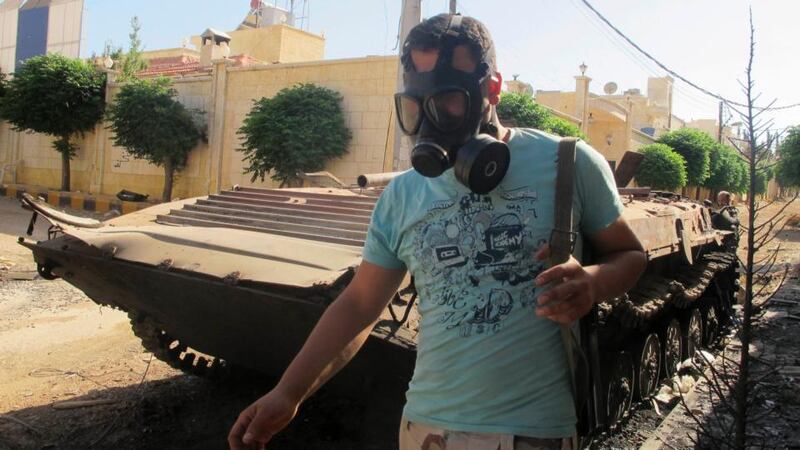The United States is considering a no-fly zone in Syria, potentially its first direct intervention into the two-year-old civil war, Western diplomats said today, after the White House said Syria had crossed a "red line" by using nerve gas.
After months of deliberation, President Barack Obama’s administration said yesterday it would now arm rebels, having obtained proof the Syrian government used chemical weapons against fighters trying to overthrow President Bashar al-Assad.
Two senior Western diplomats said Washington is looking into a no-fly zone close to Syria's southern border with Jordan.

“Washington is considering a no-fly zone to help Dr Assad’s opponents,” one diplomat said. He said it would be limited “time-wise and area-wise, possibly near the Jordanian border”.
Imposing a no-fly zone could require the United States to destroy Syria’s sophisticated Russian-built air defences, thrusting it into the war with the sort of action Nato used to help topple Muammar Gadafy in Libya two years ago.
Washington says it has not ruled out a no fly zone but has played down the prospect and said a decision is not “imminent”.
“We have not made any decision to pursue a military operation such as a no-fly zone,” US deputy national security adviser Ben Rhodes said.
“A no-fly zone would carry with it great and open-ended costs for the United States and the international community.
“It’s far more complex to undertake the type of effort, for instance, in Syria than it was in Libya.”
Any such move would also come up against a potential veto from Dr Assad’s ally Russia in the UN Security Council.
The Kremlin dismissed US evidence of Dr Assad’s use of nerve gas.
“I will say frankly that what was presented to us by the Americans does not look convincing,” President Vladimir Putin’s senior foreign policy advisor Yuri Ushakov said.
France said a no-fly zone would be impossible without UN Security Council authorisation, which made it unlikely for now.
Nevertheless, Washington has quietly taken steps that would make it easier, moving Patriot surface-to-air missiles, war planes and more than 4,000 troops into Jordan, officially as part of an annual exercise in the past week but making clear that the assets could stay on when the war games are over.
Syria’s civil war grew out of protests that swept across the Arab world in 2011, becoming by far the deadliest of those uprisings and the most difficult to resolve, with powers across the Middle East squaring off on sectarian lines.
Western countries have spent the past two years demanding Dr Assad leave power but declining to use force as they did in Libya, because of the far greater risk of fighting a much stronger country that straddles sectarian divides at the heart of the Middle East and is backed by Iran and Russia.
Just months ago, Western countries believed Dr Assad’s days were numbered. But momentum on the battlefield has turned in his favour, making the prospect of his swift removal and an end to the bloodshed appear remote without outside intervention.
Thousands of seasoned fighters from Lebanon's pro-Iranian Hezbollah militia joined the war on Dr Assad's behalf in recent weeks and last week helped the Syrian government recapture Qusair, a strategic town.
Dr Assad's government says its troops are now preparing for a massive assault on Aleppo, Syria's biggest city, mainly in rebel hands since last year.
Activists reported an intensified assault on parts of Aleppo and its countryside near the Turkish border overnight, sparking some of the most violent clashes in months.
Hezbollah’s leader Hassan Nasrallah said the guerrilla group would not be shaken in its support for Dr Assad: “Wherever we need to be, we will be.”
The arrival of Shia Hezbollah in the war on behalf of Dr Assad, a member of the Shia offshoot Alawite sect, has exacerbated the war’s dangerous sectarian overtones across the tumultuous region.
Egypt’s ruling Muslim Brotherhood backed a call by Sunni clerics for holy war.
The use of chemical weapons provides a straightforward reason for Washington to intervene.
Mr Rhodes said Washington now believed 100-150 people had been killed by government poison gas attacks on rebels.
“The president ... has made it clear that the use of chemical weapons or transfer of chemical weapons to terrorist groups is a red line,” he said.
“He has said that the use of chemical weapons would change his calculus, and it has.”
Syria, which says rebels used chemical weapons not the government, said the US statement was full of lies.
“The White House ... relied on fabricated information in order to hold the Syrian government responsible for using these weapons, despite a series of statements that confirmed that terrorist groups in Syria have chemical weapons,” the foreign ministry said in a statement.
An implicit threat to join the conflict puts Washington on a diplomatic collision course with Moscow, which has used its UN Security Council veto three times to block resolutions that might be used to threaten force against Dr Assad.
US officials sayMr Obama will try to persuade Mr Putin to abandon support for Dr Assad when the two leaders meet at a G8 summit in Northern Ireland next week.
Washington and Moscow have jointly called for a peace conference in Geneva, the first attempt in a year by the Cold War foes to find a diplomatic solution to the war, but the prospects for the talks now seem dubious.
The United Nations now estimates at least 93,000 people have been killed in Syria and millions driven from their homes.
Reuters









